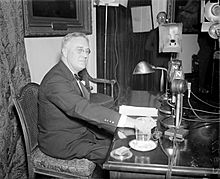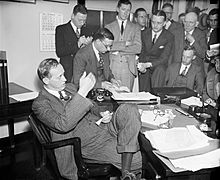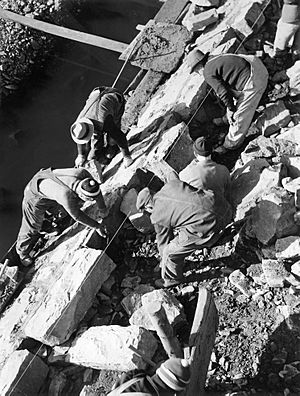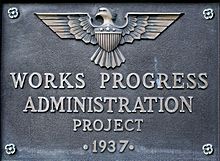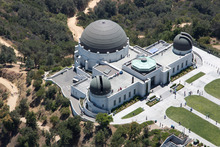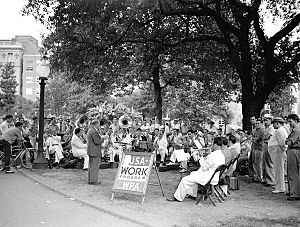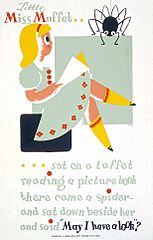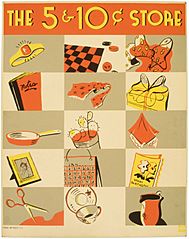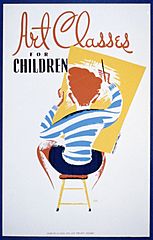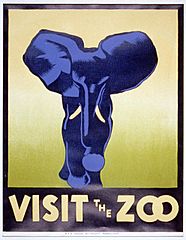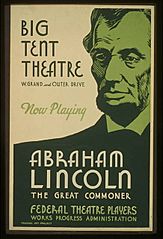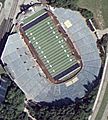Works Progress Administration facts for kids
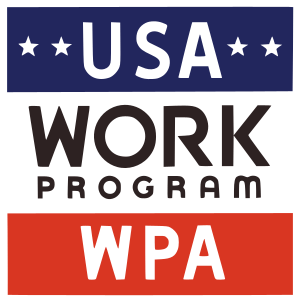 |
|
| Agency overview | |
|---|---|
| Formed | May 6, 1935 |
| Preceding | |
| Dissolved | June 30, 1943 |
| Headquarters | New York City, NY, U.S. |
| Employees | 8.5 million 1935–1943 3.3 million in November 1938 (peak) |
| Annual budget | $1.3 billion (1935) |
| Key document | |
The Works Progress Administration (or WPA) was a special government agency in the United States. It was created in 1935 during a tough time called the New Deal. The WPA helped millions of people find jobs when many were unemployed during the Great Depression.
This agency built thousands of important things like roads, schools, and government buildings. It also had a part called the Federal Art Project, which supported artists. Famous artists like Diego Rivera created murals, and plays like The Cradle Will Rock were produced. Harry Hopkins was the leader of the WPA. The program lasted until World War II began.
Contents
How the WPA Started
On May 6, 1935, President Franklin D. Roosevelt (FDR) signed an order to create the Works Progress Administration. The WPA took over from an earlier agency called the Federal Emergency Relief Administration. Instead of just giving money to people, the WPA focused on giving them jobs through big public projects.
Harry Hopkins played a huge role in shaping the WPA. He was a close advisor to President Roosevelt. Both believed that giving people jobs was the best way to help the economy recover. It also helped people keep their skills and self-respect.
The WPA was organized into several groups, each with a different job:
- The Engineering and Construction group planned and watched over building projects. These included airports, dams, roads, and sewer systems.
- The Professional and Service Projects group handled jobs for "white-collar" workers. This included teaching, recreation, and art programs.
- Other groups managed money, shared information, investigated problems, and kept track of statistics.
Who the WPA Helped
The main goal of the WPA was to give jobs to most people who were unemployed and needed help. They wanted to keep people working until the economy got better. In 1935, about 3.5 million people needed jobs. The WPA asked for $4 billion to pay for these jobs.
Many women also worked for the WPA, though fewer than men. In 1935, about 20 million people in the U.S. were receiving relief. Many of these were children, older people, or those who couldn't work. About 5.15 million people were able to work and looking for jobs. The WPA aimed to provide jobs for about 3.55 million of these workers.
The WPA had its highest number of workers in November 1938, with over 3.3 million people employed. To get a WPA job, you had to be an American citizen, at least 18 years old, able to work, unemployed, and certified as needing help.
Workers were placed in jobs based on their skills. Pay varied depending on the region, whether it was a city or rural area, and the worker's skill level. Wages ranged from $19 to $94 per month, with the average being about $52.50. The goal was to pay similar wages to local jobs, but limit hours to 8 hours a day or 40 hours a week.
Federal law said that WPA workers could not be treated unfairly because of their political views. While some vague claims were made, experts generally agree that politics played a small role in who got project jobs. However, workers were often reminded that President Roosevelt created their jobs.
What the WPA Built
The WPA built many important things that are still used today. These projects were often suggested by states, counties, or cities.
The WPA built traditional structures like roads, bridges, schools, libraries, and hospitals. But they also built museums, swimming pools, parks, playgrounds, and even zoos. They built 40,000 new buildings and improved 85,000 others. This included almost 6,000 new schools and over 9,000 new auditoriums and gyms.
They also built 2,302 stadiums, 3,185 playgrounds, and 805 swimming pools. More than $4 billion was spent on roads and streets. Over $1 billion went to public buildings like the famous Dock Street Theatre in Charleston, the Griffith Observatory in Los Angeles, and Timberline Lodge in Oregon.
The WPA also installed 20,000 miles of water pipes, which helped improve fire safety. One famous road they built was the Merritt Parkway in Connecticut, where each bridge had a unique design.
The types of projects changed over time. At first, they focused on roads and electricity. Later, they built more public facilities like parks and airports. As World War II got closer, WPA projects started focusing more on national defense. For example, they built and improved military facilities and airports.
The WPA also funded library projects, especially in rural areas where people didn't have easy access to books. They trained women for jobs in homes and helped create new library services.
Federal Project Number One: Supporting the Arts
A very important part of the WPA was called Federal Project Number One. This project had five different parts, all focused on supporting artists and cultural workers:
- The Federal Art Project
- The Federal Music Project
- The Federal Theatre Project
- The Federal Writers' Project
- The Historical Records Survey
The government wanted to support culture directly, not just by giving money to private groups. In just one year, over 40,000 artists and talented people found jobs through this project. These projects helped connect the government with the country through art, music, and stories.
Federal Art Project
This project was led by Holger Cahill. At its busiest, it employed over 5,300 artists. They created illustrations and posters for other WPA projects. They also held public art shows and taught art classes to about 50,000 children and adults. They set up over 100 art centers across the country.
Federal Music Project
Led by Nikolai Sokoloff, this project employed over 16,000 musicians. Its goal was to give jobs to musicians who were out of work. They created new groups like orchestras, bands, and opera units. They gave 131,000 performances to 92 million people each week. They also taught music classes, recorded folk music, and even explored music therapy.
Federal Theatre Project
Before the WPA, many theater workers had lost their jobs. This project was led by playwright Hallie Flanagan. It employed 12,700 performers and staff. They put on over 1,000 shows each month for almost a million people. They produced 1,200 plays and introduced 100 new playwrights. Many performers who worked here later became famous in Hollywood, like Orson Welles and Burt Lancaster. This project was the first to end, closing in June 1939.
Federal Writers' Project
This project was led by Henry Alsberg and employed 6,686 writers. By 1939, they had published over 275 books and booklets. Their most famous work was the American Guide Series. These were detailed guidebooks for every state, with descriptions of towns, historical sites, and oral histories. They also recorded important oral histories, like the Slave Narratives, and collected folklore.
Historical Records Survey
This was the smallest of the Federal Project Number One groups. It aimed to find, collect, and save historical records of the United States. It was a huge effort to document history. At its peak, it employed over 4,400 workers.
-
Poster for the WPA showing items from a 5 & 10¢ store.
Library Services Program
Before the Great Depression, many people in the U.S. didn't have easy access to public libraries. When the Depression hit, local governments couldn't afford to keep libraries open. The WPA's Library Projects aimed to fix this.
By 1938, the WPA Library Services Project had created 2,300 new libraries and 3,400 reading rooms. They also started 53 traveling libraries for rural areas. The money from the WPA only paid for workers' wages. Local communities had to provide buildings and books.
Many WPA libraries were simple, sometimes just tables of books under a tent. But people loved them, calling the WPA "the breadline of the spirit." At its peak in 1938, over 38,000 people, mostly women, worked in library services.
A main activity was repairing and mending books. This saved public and school libraries a lot of money. It also gave jobs to women, many of whom were the main providers for their families.
As World War II approached, the Library Services Program shifted focus. Libraries helped share information about national defense and provided services to military camps. By 1943, the WPA library work ended as the war created many other jobs.
The WPA library projects were very successful. They provided jobs, helped people become librarians, and kept existing librarians working. They also started new services like bookmobiles and reading rooms, which became a lasting part of American libraries. They greatly improved access to books for millions of people.
African Americans and the WPA
African Americans received a larger share of WPA benefits compared to their percentage of the population. In 1933, almost 18% of African Americans were on relief, compared to 9.5% of white people. This was during a time of Jim Crow laws and racial segregation in the South.
By 1935, about 3.5 million African Americans were on relief. Another 250,000 worked on WPA projects. In 1938, about 45% of African American families were either on relief or working for the WPA.
Some civil rights leaders initially felt that African Americans were not getting enough WPA jobs. However, by 1941, the NAACP magazine Opportunity praised the WPA. They said the WPA did a good job of preventing discrimination based on race. They noted that in northern cities, African Americans had their first real chance at "white-collar" jobs.
The WPA often had separate work groups for black and white workers. In the North, African Americans could be supervisors. But in the South, very few black supervisors were hired. Historians say that New Deal programs in the South often treated black people unfairly and continued segregation.
People with Physical Disabilities
In New York, a group called the League of the Physically Handicapped was formed in 1935. They wanted to stop the WPA from discriminating against unemployed people with physical disabilities. The WPA had been marking applications from disabled people, which meant they weren't hired.
The League held protests, and the WPA eventually agreed to create 1,500 jobs for physically disabled workers in New York City.
Women and the WPA
About 15% of the families needing help were led by women. The WPA believed that if a husband was working, his wife should not also work. This was to make sure more people could get jobs.
A study of 2,000 women working for the WPA in Philadelphia showed that most were married. However, only a small number lived with their husbands, and even fewer of their husbands had private jobs. Most of these women were responsible for supporting other family members.
In rural Missouri, 60% of the women working for the WPA did not have husbands. Many of these women worked on sewing projects. They learned to use sewing machines and made clothes and bedding for hospitals and orphanages.
One WPA-funded project, the Pack Horse Library Project, mainly hired women. These women delivered books to remote areas in eastern Kentucky, often on horseback. Many of them were the only ones earning money for their families.
Changes Over Time
In December 1938, Harry Hopkins stepped down as head of the WPA. President Roosevelt then appointed Francis C. Harrington, an engineer from the Army.
In 1939, the WPA's name was changed to the Work Projects Administration. This was to better describe its main goal of providing work projects. The WPA became part of a new group called the Federal Works Agency.
As World War II grew closer, WPA projects focused more on preparing for war. The U.S. military was small and its facilities were old. When Germany took over Czechoslovakia in 1938, the U.S. Army only had 176,000 soldiers.
In May 1940, President Roosevelt spoke about the coming war. Harrington then changed WPA priorities to support the military. This included building housing for soldiers, camps, and improving navy yards. The WPA had already built 85% of new airports in the U.S. and made many improvements to military sites. They expected 500,000 WPA workers to be on defense projects. The WPA also started training people for jobs in war industries.
Harrington passed away in 1940. His replacement, Howard O. Hunter, led the WPA until May 1942.
Why the WPA Ended
Unemployment ended when the U.S. started producing many goods for World War II. Millions of men joined the military, and companies hired and trained many more for war production.
President Roosevelt decided that a national relief program was no longer needed. In December 1942, he ordered the WPA to end. He said that providing useful work was much better than just giving out money.
Roosevelt praised the WPA for building airports, schools, and highways. He said it made clothing, served lunches to children, and helped every county in the nation. He noted that it employed 8 million Americans, giving them hope and helping them keep their skills.
Most WPA operations ended on February 1, 1943. With no money set aside for it, the WPA officially closed on June 30, 1943.
The WPA's Lasting Impact
The WPA left a huge mark on the United States. In just ten years, the WPA and other New Deal agencies built facilities in almost every community. Many of these buildings and structures are still being used today, more than 80 years later. They helped shape the public spaces we use every day.
Images for kids
-
Alabama National Guard Armory, Guntersville, Alabama (1936).
-
Prairie County Courthouse, DeValls Bluff, Arkansas (1939).
-
Griffith Observatory, Los Angeles, California (1933).
-
Santa Ana City Hall, Santa Ana, California (1935).
-
Leon High School, Tallahassee, Florida (1936–37).
-
Government House, St. Augustine, Florida (1937).
-
Fort Hawkins, Macon, Georgia (1936–1938).
-
Boise High School Gymnasium, Boise, Idaho (1936).
-
Midway International Airport, Chicago, Illinois (1935–1939).
-
Gregg Park Bandshell, Vincennes, Indiana (1939).
-
Canoe house, University of Iowa (1937).
-
Jenkins Culvert, Gove County, Kansas (1938).
-
WPA Field House and Pump Station, Scituate, Massachusetts (1938).
-
Detroit Naval Armory, Detroit, Michigan (1936–1939).
-
Brandon Auditorium and Fire Hall, Brandon, Minnesota (1936).
-
Milaca Municipal Hall, Milaca, Minnesota (1936).
-
Upland Auditorium, Upland, Nebraska (1936).
-
LaGuardia Airport, Queens, New York (1937–1939).
-
U.S. Post Office, Rhinebeck, New York (1940).
-
Robeson County Agricultural Building, Lumberton, North Carolina (1937).
-
Emmons County Courthouse, Linton, North Dakota (1934).
-
Rubber Bowl Stadium, Akron, Ohio (1940).
-
Timberline Lodge, Mt. Hood National Forest, Oregon (1936–1938).
-
Oregon State Library, Salem, Oregon (1939).
-
Schenley Park, Pittsburgh, Pennsylvania (1938–39).
-
McCoy Stadium, Pawtucket, Rhode Island (1942).
-
Dinosaur Park, Rapid City, South Dakota (1936).
-
Bristol Municipal Stadium, Bristol, Tennessee (1934).
-
Dealey Plaza, Dallas, Texas (1940).
-
Schoolhouse, Lometa, Texas (1938–1940).
-
River Walk, San Antonio, Texas (1939).
-
City Library, Monroe, Utah (1934).
-
Bremerton Public Library, Bremerton, Washington (1938).
-
White Center Fieldhouse, White Center, Washington (1938–1940).
-
Raleigh County Courthouse, Beckley, West Virginia (1936–37).
-
Mondeaux Lodge House, Westboro, Wisconsin (1936–1938).
-
Natrona County High School, Casper, Wyoming (1941).
See also
 In Spanish: Works Progress Administration para niños
In Spanish: Works Progress Administration para niños
- American Guide Series
- Federal Art Project
- Federal Project Number One
- Hatch Act of 1939
- List of Federal Art Project artists
- Presidency of Franklin D. Roosevelt
- Public Works of Art Project
- Section of Painting and Sculpture, in Treasury department
- New Deal artwork


